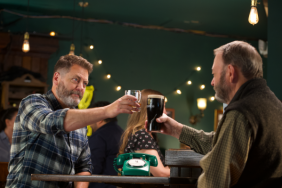
Barley, yeast and water.
Those are the only ingredients of proper Scotch – and those are the only ingredients you’ll ever find in any bottle of Glengoyne Single Highland Malt Scotch Whiskey.
For almost 200 years, there’s been a distillery on the Glengoyne grounds in the Southern Scottish Highlands just outside Glasgow. Much like many U.S. distilleries, the roots of Glengoyne reside in a past murkier than the smoked peat moss that flavors this southern blend’s northern rivals. Suffice to say, the early whiskey production around Glasgow in centuries past was less than legal.
In 1876, the Land Brothers bought the property and opened a legal establishment that remains in Scottish hands to this day — thoroughly celebrating the culture that build it and that drinks its spirits.
The process of making Scotch is much similar to brewing beer or creating Bourbon – only with different base ingredients. Genuine Scotch must be made in Scotland, just as Champagne must come from the proper region of France and Tequila must come from that province of Mexico.
While beer relies on barley and hops, and Bourbon turns to corn, Scotch begins with dry barley seeds soaked in water for hours until the seeds begin to sprout. Those sprouts are then taken to the malting floor, where they’re spread out and stirred for four to six days. Their germination and drying produces a naturally occurring sugar — a substance that will eventually cook into alcohol. If you examine the malted barley, you’ll end up with some of the white, tasteless sugar dusting your fingers.
Some northern distilleries dry the barley over burning peat moss, leaving the final Scotch with a much heavier, smoky taste and a darker color. Glengoyne passes on that step, leaving for a sweeter Scotch.
The barley is then milled into mash, soaked in a stirred tank where the distillery’s water soaked up that barley sugar. That water is drained into a massive oaken barrel. Over the next 56 hours, that barley water sits in the barrel as yeast interacts with sugar to create alcohol and carbon dioxide. Visitors can look into the barrels and watch the mix bubble, but it’s best not to breathe in over the mash.
That alcohol heads to the big copper distilling tanks where its cooked, boiled, cooked and boiled – over and over. The alcohol evaporates, collects in vapor and settles back into the water repeatedly, growing more concentrated. The alcohol goes into those cooking tanks around 50 proof and comes out at 150.
The most amazing sight was watching the master distillers check the mixture. They can smell if the alcohol is too sweet, too strong, etc. I watched Glengoyne’s Ian MacLeod sniff a beaker of young Scotch and smell a one percent error in the mix. A quick test confirmed the feat. Was it a bit of a show? Maybe. But, the point is that creating Scotch is an art form to Glengoyne’s crew.
The distilled products departs the copper cookers into Spanish Sherrie barrels where it will age into Glengoyne’s various bottled incarnations – 10, 12, 15, 18, 21, 25 year and Cask Strength. Depending on the age, the cost elevates. A bottle of the very rare 35-year-old Scotch waits in its golden bottle until a buyer comes up with £2,850.
Of course, the tour ends with a proper tasting in the gift shop where prospective buyers can have a half shot of the various aged blends and walk away with a wee souvenir of Glengoyne’s very Scottish, very spirited bottled art.
You can view more images from the boots on the ground tour here.








